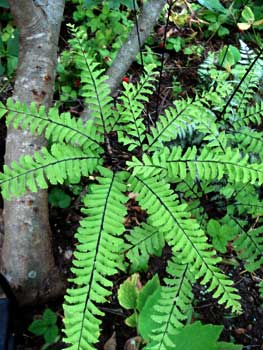
Western Maidenhair
aka, Aleutian Maidenhair
or, Five-Fingered Serpentine Fern
"The little creek goes singing
By maidenhair & moss,
Along its banks
In rosy ranks
The wild flowers wave & toss;
And ever where the ferns dip down
It sings (O sweet and low)
A lover's song."
-John Bernard O'Hara
(1864-1927)
Formerly regarded as a subspecies of Adiantum pedatum, the Western maidenhair fern (A. aleuticum) is named for the Aleutian islands, as it grows that far north.(1864-1927)
"Aleutian Maidenhair" is a misleading name since it grows all the way down to the American Southwest & Mexico, at cooler elevations where it prefers wet rocky shaded crevices. Even "Western Maidenhair" is misleading as it grows clear across the continent to New Foundland, in temperate to subarctic climates.
It looks super-delicate, but so long as it has consistent moisture, humusy soil, & shade to part shade, this is one helluva hardy fern. Established specimens, especially in deep shade, will actually recover from a bit of unintended droughtiness, but won't look nice in the interim. Though reasonably good drainage is preferred, they'll fairly easily adapt to soggier conditions at the edge of a bog-garden, & sometimes tolerate more sun when a little too wet.
This is among the most beautiful ferns on the planet Earth, as its moniker "maidenhair" means to imply. The genus name refers to the water-repelling nature of the leaves, which bow over on wiry stems during rainfall to shed water, to keep their fine lightweight foliage from being mashed by the weight of water.
The tall wire-stems are pitch black, the tops of which open into fans of graceful fonds, like hands with wide-open fingers. On a young clump there will be just a few stems upholding fronds, moving silently with the least breeze, incredibly attractive. Maturing clumps produce stems & sets of fronds in profusion, layer upon layer of beauty.
Typically a foot or a foot & a half tall, a mature specimen can be quite a bit larger, always with its delicate look. A dwarf form exists, A. aleuticum var. subpumilum.
The tough stems were used by tribal peoples in basketweaving. The fronds hold up well for bouquets as well. In the heyday of snake-oil salesmen, the standard medicine-show sales pitch alleged that Indians discovered the medicinal value of this & that. To this day, it's easy to find authors asserting, without any ethnographically valid source, that maidenhair was used by Native Americans for a dozen or so medicinal purposes. Tribal peoples did make use of the tough stems in basketweaving, but as a medicine, not until white snake-oil salesmen suggested it, as Native Americans were as susceptible as anyone to the medicine shows.
The primary claim was that it was used to treat baldness, dandruff, & for hair & scalp health generally. This was baselessly based on the "doctrine of signatures," a metaphysical theory that of God having placed a "mark" on each plant to alert mortals to its uses, & this one's "mark" was an appearance that gave rise to the name maidenhair.
Additionally, maidenhairs have in the past been used as a tonic tea for congestion of the upper respiratory tract. There is no sound evidence that this is valid.
Indeed, the use seems to have been transferred from another plant that partly shares the common name. Maidenhair Berry, today better known as creeping snowberry (Gualtheria hispidula), was one of the most popular snake-oil rememedies to come out of the Americas.
The extracted oil of the creeping snowberry was exported around the globe as the primary ingredient of "patent medicines" in the form of a flavorful syrup taken internally as a treatment for venerial diseases, tuberculosis, & all & sundry, uselessly alas. If you could get the actual leaves & berries, however, it did make a spectacularly tasty tea, requiring fermentation to bring out the flavor, & very likely does have some general health value. The maidenhair fern, however, no.
Though now rarely recommended as a healing remedy, maidenhair fern particles or teas continue to be used as an ingredient in natural products sold as "clarifying" shampoo or "conditioner" rinse or spray. It does contain tannins that might help reduce oiliness for people who have excessively oily hair.